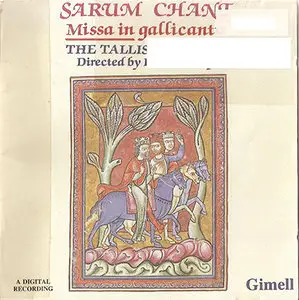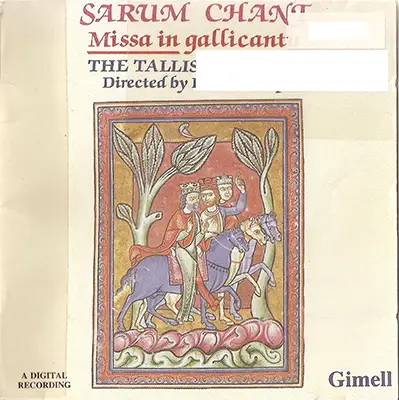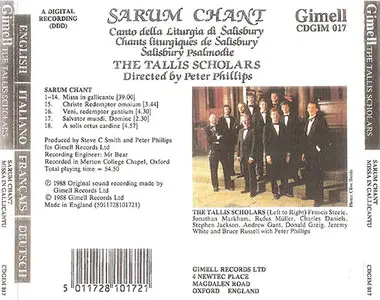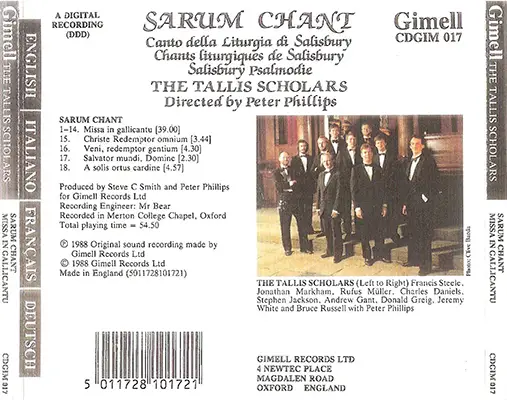The Tallis Scholars - Sarum Chant: Missa in gallicantu / the Mass at Cockcrow
Tha Tallis Scholras / Peter Philips
EAC+LOG+CUE | APE: 206 MB | Artwork | 5% Recovery Info
Label/Cat#: Gimell Records # CDGIM 017 | Country/Year: UK 1987
Genre: Classical | Style: Renaissance, Choral, Sacred
MD5 [X] CUE [X] LOG [X] INFO TEXT [X] ARTWORK [X]
my rip [ ] not my rip [X]
Exact Audio Copy V0.99 prebeta 5 from 4. May 2009
Отчёт EAC об извлечении, выполненном 23. декабря 2009, 17:09
Peter Phillips - The Tallis Scholars / Sarum Chant
Дисковод: HL-DT-STDVDRAM GSA-H10N Adapter: 2 ID: 1
Режим чтения : Достоверность
Использование точного потока : Да
Отключение кэша аудио : Да
Использование указателей C2 : Нет
Коррекция смещения при чтении : 667
Способность читать области Lead-in и Lead-out : Да
Заполнение пропущенных сэмплов тишиной : Да
Удаление блоков с тишиной в начале и конце : Нет
При вычислениях CRC использовались нулевые сэмплы : Да
Интерфейс : Установленный внешний ASPI-интерфейс
Выходной формат : Внутренние WAV-операции
Формат сэмплов : 44.100 Гц; 16 бит; стерео
TOC извлечённого CD
Трек | Старт | Длительность | Начальный сектор | Конечный сектор
––––––––––––––––––––––––––––––––––-
1 | 0:00.00 | 2:53.20 | 0 | 12994
2 | 2:53.20 | 2:47.55 | 12995 | 25574
3 | 5:41.00 | 3:48.00 | 25575 | 42674
4 | 9:29.00 | 7:36.50 | 42675 | 76924
5 | 17:05.50 | 3:26.00 | 76925 | 92374
6 | 20:31.50 | 2:05.25 | 92375 | 101774
7 | 22:37.00 | 2:55.00 | 101775 | 114899
8 | 25:32.00 | 4:45.00 | 114900 | 136274
9 | 30:17.00 | 1:43.00 | 136275 | 143999
10 | 32:00.00 | 2:22.35 | 144000 | 154684
11 | 34:22.35 | 1:47.40 | 154685 | 162749
12 | 36:10.00 | 1:27.65 | 162750 | 169339
13 | 37:37.65 | 0:41.10 | 169340 | 172424
14 | 38:19.00 | 0:49.00 | 172425 | 176099
15 | 39:08.00 | 3:44.00 | 176100 | 192899
16 | 42:52.00 | 4:30.00 | 192900 | 213149
17 | 47:22.00 | 2:31.00 | 213150 | 224474
18 | 49:53.00 | 4:58.00 | 224475 | 246824
Характеристики диапазона извлечения и сообщения об ошибках
Выбранный диапазон
Имя файла W:\ProBit\1 No\Sarum Chant (The Tallis Scholars)\Sarum Chant.wav
Подозрительная позиция 0:37:52 - 0:37:53
Пиковый уровень 57.5 %
Качество диапазона 99.9 %
CRC теста 7227ACB0
CRC копии 2198077C
Копирование завершено
Были ошибки
AccurateRip: сводка
Трек 1 точное извлечение (доверие 6) [6C13D747]
Трек 2 точное извлечение (доверие 6) [5A265929]
Трек 3 точное извлечение (доверие 6) [66A4E05E]
Трек 4 точное извлечение (доверие 6) [9202A957]
Трек 5 точное извлечение (доверие 6) [B063D163]
Трек 6 точное извлечение (доверие 6) [0745FBFF]
Трек 7 точное извлечение (доверие 6) [908EDA57]
Трек 8 точное извлечение (доверие 6) [8658655B]
Трек 9 точное извлечение (доверие 6) [CCCC34C7]
Трек 10 точное извлечение (доверие 6) [2C69F96B]
Трек 11 точное извлечение (доверие 6) [EC367B5B]
Трек 12 точное извлечение (доверие 6) [30BD876E]
Трек 13 точность не определена (достоверность 6) [88BEA887], AccurateRip вернул [341F0741]
Трек 14 точное извлечение (доверие 6) [A01C0069]
Трек 15 точное извлечение (доверие 6) [05C7DCC3]
Трек 16 точное извлечение (доверие 6) [169BB79E]
Трек 17 точное извлечение (доверие 6) [C91677B9]
Трек 18 точное извлечение (доверие 6) [F47442BC]
17 трек(и) скопированы точно
1 трек(и) не удалось проверить на точность
Некоторые треки не прошли проверку на точность
Конец отчёта
Отчёт EAC об извлечении, выполненном 23. декабря 2009, 17:09
Peter Phillips - The Tallis Scholars / Sarum Chant
Дисковод: HL-DT-STDVDRAM GSA-H10N Adapter: 2 ID: 1
Режим чтения : Достоверность
Использование точного потока : Да
Отключение кэша аудио : Да
Использование указателей C2 : Нет
Коррекция смещения при чтении : 667
Способность читать области Lead-in и Lead-out : Да
Заполнение пропущенных сэмплов тишиной : Да
Удаление блоков с тишиной в начале и конце : Нет
При вычислениях CRC использовались нулевые сэмплы : Да
Интерфейс : Установленный внешний ASPI-интерфейс
Выходной формат : Внутренние WAV-операции
Формат сэмплов : 44.100 Гц; 16 бит; стерео
TOC извлечённого CD
Трек | Старт | Длительность | Начальный сектор | Конечный сектор
––––––––––––––––––––––––––––––––––-
1 | 0:00.00 | 2:53.20 | 0 | 12994
2 | 2:53.20 | 2:47.55 | 12995 | 25574
3 | 5:41.00 | 3:48.00 | 25575 | 42674
4 | 9:29.00 | 7:36.50 | 42675 | 76924
5 | 17:05.50 | 3:26.00 | 76925 | 92374
6 | 20:31.50 | 2:05.25 | 92375 | 101774
7 | 22:37.00 | 2:55.00 | 101775 | 114899
8 | 25:32.00 | 4:45.00 | 114900 | 136274
9 | 30:17.00 | 1:43.00 | 136275 | 143999
10 | 32:00.00 | 2:22.35 | 144000 | 154684
11 | 34:22.35 | 1:47.40 | 154685 | 162749
12 | 36:10.00 | 1:27.65 | 162750 | 169339
13 | 37:37.65 | 0:41.10 | 169340 | 172424
14 | 38:19.00 | 0:49.00 | 172425 | 176099
15 | 39:08.00 | 3:44.00 | 176100 | 192899
16 | 42:52.00 | 4:30.00 | 192900 | 213149
17 | 47:22.00 | 2:31.00 | 213150 | 224474
18 | 49:53.00 | 4:58.00 | 224475 | 246824
Характеристики диапазона извлечения и сообщения об ошибках
Выбранный диапазон
Имя файла W:\ProBit\1 No\Sarum Chant (The Tallis Scholars)\Sarum Chant.wav
Подозрительная позиция 0:37:52 - 0:37:53
Пиковый уровень 57.5 %
Качество диапазона 99.9 %
CRC теста 7227ACB0
CRC копии 2198077C
Копирование завершено
Были ошибки
AccurateRip: сводка
Трек 1 точное извлечение (доверие 6) [6C13D747]
Трек 2 точное извлечение (доверие 6) [5A265929]
Трек 3 точное извлечение (доверие 6) [66A4E05E]
Трек 4 точное извлечение (доверие 6) [9202A957]
Трек 5 точное извлечение (доверие 6) [B063D163]
Трек 6 точное извлечение (доверие 6) [0745FBFF]
Трек 7 точное извлечение (доверие 6) [908EDA57]
Трек 8 точное извлечение (доверие 6) [8658655B]
Трек 9 точное извлечение (доверие 6) [CCCC34C7]
Трек 10 точное извлечение (доверие 6) [2C69F96B]
Трек 11 точное извлечение (доверие 6) [EC367B5B]
Трек 12 точное извлечение (доверие 6) [30BD876E]
Трек 13 точность не определена (достоверность 6) [88BEA887], AccurateRip вернул [341F0741]
Трек 14 точное извлечение (доверие 6) [A01C0069]
Трек 15 точное извлечение (доверие 6) [05C7DCC3]
Трек 16 точное извлечение (доверие 6) [169BB79E]
Трек 17 точное извлечение (доверие 6) [C91677B9]
Трек 18 точное извлечение (доверие 6) [F47442BC]
17 трек(и) скопированы точно
1 трек(и) не удалось проверить на точность
Некоторые треки не прошли проверку на точность
Конец отчёта
foobar2000 1.1.14a / Dynamic Range Meter 1.1.1
log date: 2014-10-18 16:17:06
––––––––––––––––––––––––––––––––––––––––
Analyzed: Peter Phillips - The Tallis Scholars / Sarum Chant
––––––––––––––––––––––––––––––––––––––––
DR Peak RMS Duration Track
––––––––––––––––––––––––––––––––––––––––
DR13 -12.72 dB -30.54 dB 2:53 01-Missa in gallicantu: Introitus (Officium) Dominus dixit ad me
DR14 -5.29 dB -26.56 dB 2:48 02-Missa in gallicantu: Kyrie: Deus Creator omnium
DR15 -6.09 dB -28.44 dB 3:48 03-Missa in gallicantu: Gloria
DR16 -9.14 dB -31.19 dB 7:37 04-Missa in gallicantu: Laudes Deo
DR14 -6.63 dB -27.53 dB 3:26 05-Missa in gallicantu: Graduale; Tecum principium
DR12 -6.71 dB -25.69 dB 2:05 06-Missa in gallicantu: Alleluia; Dominus dixit
DR14 -4.80 dB -21.84 dB 2:55 07-Missa in gallicantu: Sequentia; Nato canunt omnia
DR14 -5.30 dB -25.35 dB 4:45 08-Missa in gallicantu: Credo
DR13 -6.67 dB -25.36 dB 1:43 09-Missa in gallicantu: Offertorium; Laetenur caeli
DR13 -8.49 dB -28.21 dB 2:22 10-Missa in gallicantu: Praefatio
DR12 -7.01 dB -27.07 dB 1:48 11-Missa in gallicantu: Sanctus
DR12 -9.42 dB -31.21 dB 1:28 12-Missa in gallicantu: Agnus Dei
DR12 -12.51 dB -30.68 dB 0:41 13-Missa in gallicantu: Communio; In splendoribus sanctorum
DR11 -5.60 dB -24.83 dB 0:49 14-Missa in gallicantu: Dimissio
DR15 -9.06 dB -31.06 dB 3:44 15-Christe Redemptor omnium
DR15 -7.45 dB -28.23 dB 4:30 16-Veni, redemptor gentium
DR15 -8.22 dB -30.44 dB 2:31 17-Salvator mundi, Domine
DR15 -5.16 dB -25.64 dB 4:58 18-A solis ortus cardine
––––––––––––––––––––––––––––––––––––––––
Number of tracks: 18
Official DR value: DR14
Samplerate: 44100 Hz
Channels: 2
Bits per sample: 16
Bitrate: 526 kbps
Codec: Monkey's Audio
================================================================================
log date: 2014-10-18 16:17:06
––––––––––––––––––––––––––––––––––––––––
Analyzed: Peter Phillips - The Tallis Scholars / Sarum Chant
––––––––––––––––––––––––––––––––––––––––
DR Peak RMS Duration Track
––––––––––––––––––––––––––––––––––––––––
DR13 -12.72 dB -30.54 dB 2:53 01-Missa in gallicantu: Introitus (Officium) Dominus dixit ad me
DR14 -5.29 dB -26.56 dB 2:48 02-Missa in gallicantu: Kyrie: Deus Creator omnium
DR15 -6.09 dB -28.44 dB 3:48 03-Missa in gallicantu: Gloria
DR16 -9.14 dB -31.19 dB 7:37 04-Missa in gallicantu: Laudes Deo
DR14 -6.63 dB -27.53 dB 3:26 05-Missa in gallicantu: Graduale; Tecum principium
DR12 -6.71 dB -25.69 dB 2:05 06-Missa in gallicantu: Alleluia; Dominus dixit
DR14 -4.80 dB -21.84 dB 2:55 07-Missa in gallicantu: Sequentia; Nato canunt omnia
DR14 -5.30 dB -25.35 dB 4:45 08-Missa in gallicantu: Credo
DR13 -6.67 dB -25.36 dB 1:43 09-Missa in gallicantu: Offertorium; Laetenur caeli
DR13 -8.49 dB -28.21 dB 2:22 10-Missa in gallicantu: Praefatio
DR12 -7.01 dB -27.07 dB 1:48 11-Missa in gallicantu: Sanctus
DR12 -9.42 dB -31.21 dB 1:28 12-Missa in gallicantu: Agnus Dei
DR12 -12.51 dB -30.68 dB 0:41 13-Missa in gallicantu: Communio; In splendoribus sanctorum
DR11 -5.60 dB -24.83 dB 0:49 14-Missa in gallicantu: Dimissio
DR15 -9.06 dB -31.06 dB 3:44 15-Christe Redemptor omnium
DR15 -7.45 dB -28.23 dB 4:30 16-Veni, redemptor gentium
DR15 -8.22 dB -30.44 dB 2:31 17-Salvator mundi, Domine
DR15 -5.16 dB -25.64 dB 4:58 18-A solis ortus cardine
––––––––––––––––––––––––––––––––––––––––
Number of tracks: 18
Official DR value: DR14
Samplerate: 44100 Hz
Channels: 2
Bits per sample: 16
Bitrate: 526 kbps
Codec: Monkey's Audio
================================================================================
CD Info:
The Tallis Scholars - Sarum Chant: Missa in gallicantu - the Mass at Cockcrow
Label: Gimell Records
Catalog#: CDGIM 017
Format: CD, Album
Country: UK
Released: 1987
Genre: Classical
Style: Renaissance, Choral, Sacred
Tracklist:
Bishop Giles de Bridport - Missa in gallicantu
1. Tntroitus (Officium): Dominus dixit ad me
2. Kyrie: Deus Creator omnium
3. Gloria
4. Laudes Deo (Soloists: Rufus Müller & Charles Daniels)
5. Graduale: Tecum principium
6. Alleluia: Dominus dixit
7. Sequentia: Nato canunt omnia
8. Credo
9. Offertorium: Laetentur caeli
10. Praefatio
11. Sanctus
12. Agnus Dei
13. Communio: In splcndoribus sanctorum
14. Dimissio
Four Hymns
15. Christe Redemptor omnium
16. Veni, redemptor gentium
17. Salvator mundi, Domine
18. A solis ortus cardine
The Tallis Scholars directed by Peter Phillips
Tenor: Charles Daniels, Rufus Muller, Andrew Gant
Baritone: Donald Greig, Jonathan Markham, Bruce Russell
Bass: Francis Steele, Jeremy White, Stephen Jackson
Celebrant: Jeremy White.
Bells: Ivan Moody
Chant for the First Mass of Christmas according to the Salisbury Rite. It would have been celebrated after midnight on Christmas Eve, and was known as the Missa in gallicantu - the Mass at Cockcrow. The chant has been taken from printed sources which would have been in use when composers such as Tallis and Tye were at the height of their powers.
The Church of Salisbury shines as the sun in its orb among the Churches of the whole world in its divine service and those who minister it, and by spreading its rays everywhere makes up for the defects of others.
Thus wrote the Bishop Giles de Bridport, in about 1256, of what has come to be called the 'Sarum Rite'. The liturgy of the Roman Catholic Church had crystallized, during its travels abroad from the 7th Century onwards, into distinct 'uses' - variations upon the fundamentally Roman ritual, according to country, region, or province (1). The use of Salisbury early became pre-eminent among the various rites of England.
The See of Salisbury was moved to the present cathedral site in 1218, and under a succession of efficient and zealous bishops, its liturgy became the envy of the rest of the country. Indeed, it all but usurped many other rites (such as those of York and Hereford), and its statutes and rules were copied by monastic and secular foundations all over Great Britain. One strand of this liturgical web even reached Portugal - 1385 saw the introduction of the Salisbury Rite at Braga.
The music recorded here is from the First Mass of Christmas according to the Salisbury Rite. It would have been celebrated after midnight on Christmas Eve, and was known as the Missa in gallicantu - the Mass at Cockcrow. The chant has been taken from printed sources which would have been in use when composers such as Tallis and Tye were at the height of their powers (2).
Mass begins with the Introit (which was called Officium at Salisbury), Dominus dixit ad me. The chant is begun by the 'rulers' (leaders) of the choir, and is composed of an antiphon surrounding a psalm verse and the doxology. The Kyrie follows immediately, here in a troped version called Kyrie cum versibus. Tropes were extra sections of texts inserted into a liturgical composition in order to expand and amplify its meaning, and make it relevant to particular occasions. In this example, the inserted texts actually replace the original words; thus, instead of simply 'Kyrie, eleison' (Lord, have mercy), we hear 'Deus Creator omnium, Tu Theos ymon nostri pie eleison' (O God, Creator of all things and our God, be gracious and have mercy on us). This procedure occurs in all of the Kyrie's nine invocations, and the text retains a few words of Greek amongst the Latin.
The Gloria is intoned by the celebrant from the altar. Like the Kyrie, it is very syllabic, and moves within a fairly restricted range, never straying further than an octave above its first note. The Collect would then have followed, and then a lesson from the Book of Isaiah. This lesson is sung here in a special troped form, known as the Laudes Deo from its opening words. It is sung by two clerks, one having the lesson itself, the other interpolating the troped sections. Both singers join together to proclaim the final sentence. The Epistle would then have been read by the subdeacon.
Tecum principium, the Gradual, is intoned by three clerks. It is the most florid chant so far heard, several words having extensive melismata. The range is also large - a tenth in all. Similarly elaborate is the Alleluia, which follows immediately. Its verse is 'Dominus dixit', the same text as the Introit antiphon.
Quite different in style is the Sequence. This is a genre that arose from greatly lengthening the final syllable of the preceding Alleluia, a practice which seems to have developed in the eighth and ninth centuries. Texts became attached to these huge melismatic passages, and they later acquired separate status as Sequences. As with many other examples, Nato canunt omnia is constructed of pairs of rhyming stanzas in the same metre. This poetic structure is reflected in the musical material. It is sung antiphonally, and bells are rung to emphasize the festal nature of the chant.
After the Gospel, which would have been read by the deacon (here omitted), the Credo (the Nicene Creed) is intoned by the celebrant. The Sarum Rite had only one melody for the Creed, in contrast to the Roman, which has several. This is succeeded by the celebrant's salutation to the congregation, and the Offertory, during which the bread and wine would have been offered at the altar. The Offertory was originally a lengthy example of antiphonal psalmody, but was made shorter when the practice of omitting verses became standard. The Secret would then have followed: a prayer read by the celebrant in a low voice.
The Preface begins with the Sursum corda (Lift up your hearts), and ends with the words '…we sing the hymn of your glory as we ceaselessly proclaim:' as the introduction to the Sanctus (Holy, holy, holy), which is intoned by rulers and continued by full choir. The eucharistic prayer would then have been continued by the celebrant, the elevation of the Host occurring during the Canon. The Pater noster and the fraction would have followed, with the Pax, or Kiss of Peace. Agnus Dei, the threefold invocation of the Lamb of God, is the final item of the Mass Ordinary. (The Ordinary today consists of the Kyrie, Gloria, Credo, Sanctus, and Agnus Dei - the items of the Mass which do not change - in contrast with the Proper - items with texts changing according to occasion. Due to the practice of troping according to feast, the Kyrie in England during the Middle Age effectively became part of the Proper.)
The Communion is In splendoribus sanctorum, a short chant sung during the reception of the Host. After communion the celebrant would again have saluted the congregation and said the post-communion prayer. The dismissal is sung by the deacon: 'Go, the Mass is ended' - the people reply 'thanks be to God!', and the Mass ends.
The four hymns recorded here are from the Divine Offices of Christmas Day: Christe redemptor omnium is from Matins, Veni, redemptor gentium from Vespers, Salvator mundi, Domine from Compline, and A solis ortus cardine from Lauds. These are some of the best known plainchant hymn tunes, and are often used today, whether in Latin or in the vernacular. They possess an immediacy of melodic appeal and a memorable rhythmic character. Hymn tunes at this time were often used again with different sets of words; Veni, redemptor, for example, also appears as Iesu Salvator saeculi, for First Vespers of the Feast of All Saints.
© 1988 Ivan Moody
(1) Rites with sufficiently ancient pedigree were permitted to remain independent of the Roman liturgy. The Ambrosian Rite is the most famous example, and it is indeed still extant.
(2) Sources consulted include the Missal of 1531, and the Graduals of 1528 and 1532.
Thanks to Karl Каменный!







